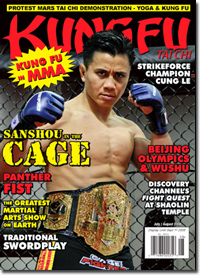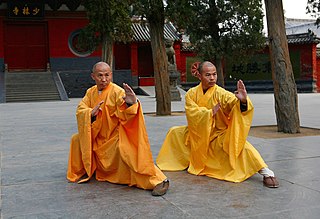
In general, kung fu/kungfu refers to the Chinese martial arts also called wushu and quanfa. In China, it refers to any study, learning, or practice that requires patience, energy, and time to complete. In its original meaning, kung fu can refer to any discipline or skill achieved through hard work and practice, not necessarily martial arts. The literal equivalent of "Chinese martial art" in Mandarin would be 中國武術 zhōngguó wǔshù.

Nei jia is the collective name for the internal Chinese martial arts. It relates to those martial arts occupied with spiritual, mental or qi-related aspects, as opposed to an "external" approach focused on physiological aspects. The distinction dates to the 17th century, but its modern application is due to publications by Sun Lutang, dating to the period of 1915 to 1928. Nei jing is developed by using nei gong or "internal changes", contrasted with wài gōng or "external exercises".

Tai chi, short for Tai chi ch'üan, sometimes called "shadowboxing", is an internal Chinese martial art practiced for defense training, health benefits and meditation. Tai chi has practitioners worldwide.
Bow-sim Mark is a Chinese martial arts grandmaster who lives in Newton, Massachusetts, US. She is the mother of martial arts film star, Donnie Yen.

Yuen Woo-ping is a Hong Kong martial arts choreographer and film director who worked in Hong Kong action cinema and later Hollywood films. He is one of the inductees on the Avenue of Stars in Hong Kong. Yuen is also a son of Yuen Siu-tien, a martial arts film actor.

William Cheung or Cheung Cheuk-hing is a Hong Kong Wing Chun kung fu practitioner and currently the Grandmaster of his lineage of Wing Chun, entitled Traditional Wing Chun (TWC). He also heads the sanctioning body of TWC, the Global Traditional Wing Chun Kung Fu Association (GTWCKFA). He is the recipient of a Masters Award for lifetime achievement in Kung Fu from Martial Arts Australia.

Fujian White Crane, also known as White Crane Style is a Southern Chinese martial art that originated in Yongchun County, Fujian (福建) province. According to oral tradition, the style was developed by Fang Qiniang, a female martial artist. It is associated with traditional fighting techniques, including long range, but is most similar to close-quarter or hand-to-hand combat. It is most recognizable by the way the fighter imitates a bird's pecking or flapping of wings. While some white crane styles make use of traditional weapons, others have discontinued the use of weaponry.

Wushu, or Kung fu, is a hard and soft and complete martial art, as well as a full-contact combat sport. It has a long history in reference to Chinese martial arts. It was developed in 1949 in an effort to standardize the practice of traditional Chinese martial arts, yet attempts to structure the various decentralized martial arts traditions date back earlier, when the Central Guoshu Institute was established at Nanking in 1928.
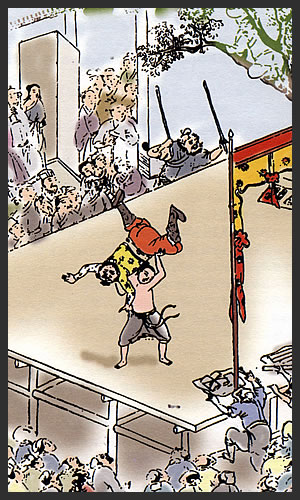
The lei tai is an elevated fighting arena, without railings, where often fatal weapons and bare-knuckle martial arts tournaments were once held. "Sanctioned" matches were presided over by a referee on the platform and judges on the sides. Fighters would lose if they surrendered, were incapacitated, or were thrown or otherwise forced from the stage. The winner would remain on the stage unless ousted by a stronger opponent. If there were no more challengers, they would become the champion. Private duels on the stage had no rules and were sometimes fought to the death.

Bruce Leung Siu-lung is a Hong Kong martial artist and actor who has appeared in many Hong Kong martial arts movies. He often appeared billed as "Bruce Leung", "Bruce Liang", "Bruce Leong", or "Bruce Leung Siu-lung", and is thus generally grouped among the Bruce Lee clones that sprang up after Lee's death in the subgenre known as Bruceploitation.
Stephan Berwick is an American author, martial artist, and actor known for his scholarly research on traditional Chinese martial arts – particularly Chen-style taijiquan, and roles in early Yuen Wo-ping Hong Kong Action films.

Fu Style Wudang Fist is a family style of Chinese martial arts encompassing T'ai chi ch'uan, Xing-Yi chuan, Bagua zhang, LiangYi chuan, Baji chuan and Wudang Sword. Fu Style Baguazhang is one of the five styles of baguazhang recognized as orthodox in China. It is the precipice and highest-form of the Fu Style martial arts.
Helen Wu is Chinese Muslim martial artist living in Toronto, Ontario, Canada. The daughter of Wang Ju-Rong and Wu Chengde began her martial arts training at age three with her mother and her grandfather Wang Zi-Ping, the world-renowned Wushu Grandmaster.
Wang Jurong was a Chinese-Muslim martial artist and Wushu professor in the Shanghai Institute of Physical Education.

Yang Jun is a Wushu master who was born in Taiyuan, Shanxi, China in 1968 into the famous Yang family of martial artists. A son of Yang Dao Fang and a grandson of Yang Zhenduo, he is a direct descendant of Yang Cheng Fu and of Yang Lu Chan, the creator of Yang-style t'ai chi ch'uan. Yang Jun is a sixth-generation descendant of the Yang Family of t'ai chi ch'uan, and is the fifth lineage-holder of the style.

Doc-Fai Wong (黄德輝) is recognized internationally as a master of the Hung Sing branch of Choy Li Fut kung fu and T'ai chi ch'uan. He was born in 1948 in the Guangdong (广东) province of China; the Wangshan village of Wushan - Doumen district of Zhuhai City. In April 1960, he immigrated to San Francisco, California with his mother to be reunited with his father. He arrived as a third-generation citizen of the United States of America since both his grandfather and father were already citizens. He sought out his first kung fu teacher - Lau Bun (劉彬), the founder of the first Hung Sing Kwoon of Choy Li Fut in America, after encountering taunting and bullying due to language and ethnic difficulties after his arrival. When Lau Bun died in 1967, he started teaching and opened his first school when he was 19 years old.

Wudang quan is a class of Chinese martial arts. In contemporary China, Chinese martial arts styles are generally classified into two major groups: Wudang (Wutang), named after the Wudang Mountains; and Shaolin, named after the Shaolin Monastery. Whereas Shaolin includes many martial art styles, Wudangquan includes only a few arts that use the focused mind to control the body. This typically encompasses taijiquan, xingyiquan and baguazhang, but must also include Baji chuan and Wudang Sword. Although the name Wudang simply distinguishes the skills, theories and applications of the internal arts from those of the Shaolin styles, it misleadingly suggests these arts originated at the Wudang Mountains. The name Wudang comes from a popular Chinese legend that incorrectly purports the genesis of taijiquan and Wudang Sword by an immortal, Taoist hermit named Zhang Sanfeng who lived in the monasteries of Wudang Mountain.
Christopher Dow is an American writer. He is the author of three volumes of poetry, four novels, a collection of essays and a theoretical book on the martial art of t'ai chi ch'uan. A practitioner of t'ai chi for more than 30 years, Dow has written articles on these subjects that have appeared in Tai Chi Magazine, Inside Kung Fu and Yoga Journal. He also wrote, directed and produced several video productions, including a documentary series on the first nationally sanctioned kung fu tournament in the United States, the U.S. National Chinese Martial Arts Competition.
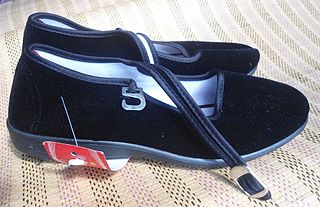
The kung fu shoe, also known as a "Tai Chi shoe" or as a "martial arts slipper", is a type and style of cloth slip-on shoe that is traditionally made in China, and was originally worn while practicing kung fu and other martial arts, and also while performing Tai Chi.
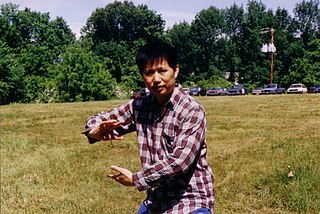
Zhang Luping was a Chinese martial artist and mathematician born in Jiaxing, Zhejiang province. He was best known in China for his exceptional skill at tai chi's push hands, and for an incident in his hometown in which he accidentally broke a weightlifting champion’s forearm during an arm wrestling match. He was a student of Cai Hong Xiang (蔡鸿祥), Wang Zi-Ping (王子平), and Fu Zhong Wen (傅鍾文). He was also a descendant of Zhang Jun and of Zhang Jiugao, who was the brother of Zhang Jiuling. He was noted for his deep knowledge of the five styles of tai chi, his superb application of the principles, and his highly developed internal power. In an age when many great martial arts teachers remained reluctant to share their highest insights and techniques, Zhang championed in his teaching an attitude of openness and a strong desire to ensure the continuation of Chinese martial traditions.
